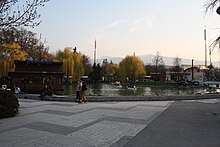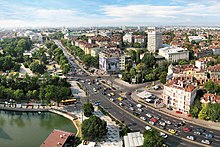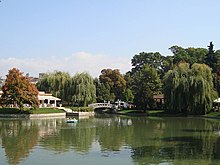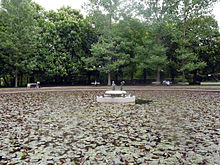Borisova gradina
The park Borissowa gradina ( Bulgarian Борисова градина , to German about Borisgarten ) or Knjas -Borissowa gradina (Bulgarian Княз-Борисова градина ) is the oldest and best-known park in the Bulgarian capital Sofia , after the Bulgarian Tsar of Sofia III. is named. The park was created in 1884. The Bulgarian word gradina means a small garden or park.
This park is the largest park in Sofia. Today it covers an area of 445 hectares (= 4.45 km²). Of this, however, only the northern part (1300 × 700 m) is developed as a park, while the remaining areas are more like a forest through which developed paths lead. In the developed part of the park there are numerous avenues, including two small lakes and a large children's playground.
When the park was created, it was on the south-eastern outskirts of Sofia. Because of the strong urban expansion of Sofia after 1945, the park is now almost in the city center, it borders directly to the south-east of the city center and is considered the green lung of Sofia. In 1896 the park was declared a monument of national importance, a model and monument of Bulgarian garden and park art.
The park's avenues are partially paved.
Names
The first name of the park was Rassadnika (Bulgarian Разсадника ; Bulgarian for plant garden, gardening or tree nursery), later it was renamed Pépinière (French for nursery or tree nursery ; Bulgarian Пипиниера / Pipiniera). The names Gradska pepiniera (Градска пепиниер / Städtischer Pflanzgarten) and Rassadna gradina (Разсадна градина / Pflanzgarten) were also used. Until 1885 the park was also known under the name Zarigradska gradina (Bulgarian Цариградска градина ). This name is derived from the arterial road to Istanbul - Zarigradsko schose (Bulgarian Цариградско шосе ), which borders the north-east side of the park. Tsarigrad, the "city of the tsar ", was the old Bulgarian name for the capital of the Eastern Roman emperors ( Constantinople ), later the capital of the sultans of the Ottoman Empire , which was not officially called Istanbul until 1930.
After the birth of the heir to the throne Boris Tarnowski on October 3, 1918, the later Tsar Boris III., The park was renamed " Knjas Borissowa gradina" (Bulgarian Княз-Борисова градина ; also: Prince Boris Park). During the reign of the Bulgarian Communist Party (1944-1989) the name of the park was changed to Park of Freedom (Bulgarian Парка на свободата / Parka na swobodata). After the democratization of Bulgaria, the park was renamed "Borissowa gradina" again in 1990.
history
The history of the park can be divided into three periods, each shaped by a well-known landscape gardener. However, all of them followed the original plan for the park and developed it further without making radical changes to the original design.
Until the liberation of Bulgaria from Ottoman rule in 1878, the area of today's park was an Ottoman military training area.
Sofia became the capital of the Principality of Bulgaria on April 3, 1879 , at that time there was only a small city garden of Sofia (Bulgarian градска градина ) in front of today's National Theater "Ivan Wasow" (Bulgarian Народен театър "Иван Вазов" ).
Daniel Neff (Head: 1882–1900)
In 1879 the majority of today's Borissowa Gradina Park was rededicated as a Turkish cemetery by a decision of the Sofia municipality. On March 22, 1882, the Sofia City Council decided unanimously to the proposal of the Sofia Mayor Ivan Chadschienow ( Bulgarian Иван Хаджиенов ) to set up a park on the southeastern city limits. Until then, the planned area consisted mainly of private gardens and agricultural areas. These were bought from the owners during the reign of Prince Ferdinand I (1887–1918).
The critics of this park project referred, but without success, to the much more urgent need for high investment in the decaying unpaved streets of Sofia and the need to set up gas lamps on the streets.
The Mayor of Sofia brought the famous court gardener of the Romanian King Charles I , the Swiss Daniel Neff (1843–1900), to Sofia in 1882 and commissioned him to create a park. Neff had made a name for himself with very beautiful parks and gardens and was in charge of the park in Sofia from 1884 to 1890. In 1883 Neff became a Bulgarian citizen.
In order to have enough plants available for the creation of a park, a large nursery and tree nursery (French: Pépinière) should first be operated in order to obtain the required quantities of trees, bushes and flowers for the future park. The plants grown in the park's nursery were also used to green the streets of Sofia, which had not been green until then. This first planting as a nursery at the end of the 19th century even generated income for the municipality of Sofia, as the tree cuttings were not only used for public parks, royal gardens and green streets, but were also offered for sale to the population. In 1891, for example, the city treasury received 10,000 leva from the sale of young plants.
In the spring of 1882, Neff drafted the first plan for the park, built a house near the Adlerbrücke and organized the Pépinière, located near the river Perlowska reka (Bulgarian Перловска река ) right next to his house . The river flows on the northwest side of the park and is now channeled in an artificial concrete bed. At that time the river marked the southeastern city limits of Sofia. The irrigation was initially carried out with water that was carted in from the river in wooden barrels. Fixed water pipes were later installed in the park, which were fed with water from the river.
After the planning phase in 1883, Neff began building the park in 1884. First, rows of locust trees (Robinai pseudoacacia) were planted, flower beds and a small lake (the fish pond) were created and surrounded by hedges made of oak and hawthorn .
Besides acacia mainly were gods trees , catalpa , Japanese string trees , mulberry trees , plane trees and elms used.
The nursery was converted into a park in 1885, which in 1886 already covered an area of 30 hectares . Four main avenues were laid out that ran parallel to the Zarigradsko schose . The park was bordered by the Zarigradsko schose in the northeast, the Perlowska reka in the northwest, the old Turkish cemetery and Neff's house.

The park was extended along the Zarigradsko Schose from the Adlerbücke to the southeast and to the southwest along the Parlovska reka to the current location of the Vasil Levski National Stadium . In addition, in 1889 a large lake (boat pond), Lake Ariana ( Bulgarian езеро Ариана ) ( 42 ° 41 ′ 21 ″ N , 23 ° 20 ′ 12 ″ E ) was created at the entrance to the park, in the immediate vicinity of the Eagle Bridge. According to other sources, it was created in 1904 and 1942, respectively. That was the first boat pond in Sofia. The lake has a small island to which a small stone bridge led, and on the island of Stand a small pavilion with a snack stand. Today row boats and pedal boats drive on the small boat pond. In winter there is ice-skating on the pond.
Ferdinand I , who became Tsar of Bulgaria on July 7, 1887 (gregor.), Had ambitious plans to green Sofia based on the model of Vienna . At his request, the planting of the park was fundamentally changed in 1888. He was bothered by the monotony of the acacias; they were replaced by mountain oak, maple , ash and birch , among other things . These trees were brought from the Losenez forest, now part of Sofia.
In the years that followed, various types of conifers were grown from the Pasarelsk Forest, the village Dolni Pasarel (Bulgarian Долни Пасарел ) located 30 km south of Sofia at the foot of the Losenska Mountains (Bulgarian Лозенска планина / Losenska planina), and from the forest of Kokaljanska Kokaljane (Bulgarian Кокаляне ) is located 18 south of the center of Sofia at the foot of the Vitosha Mountains , brought up and planted. In order to make the tree population even more diverse, hundreds of conifers ( black pines and spruces) from Tscham korija (today Borowez ) in the Rila Mountains were driven over 70 km on ox carts .
Today's lily pond ( 42 ° 41 ′ 7 ″ N , 23 ° 20 ′ 33 ″ E ), where there used to be a small marshland, was originally a fish pond (Bulgarian Рибно езеро ) and later as a lily pond (Bulgarian Езеро с лилиите ) designated.
Against Neff's plans to expand the park to the surrounding fallow land, which Schopen from the neighboring village of Slatina - today the Slatina district - used as traditional pastureland, the whole village rose.
During their protest actions, the villagers beat Witan Minkow, the only worker and park attendant, to death several times with clubs. In February 1903 the mayor sent mounted police against the rebellious cattle farmers, but the police were viciously chased away. As a result, an entire military division, a squadron , was sent out to break popular resistance to the park's expansion. Two people died and dozen were injured in the shooting that followed.
After Daniel Neff's death in 1900, his work was continued by his son Karl Neff (1900–1902) and Emil Aman (1902–1903).
The Sofia Spiritual Academy was built on the wheel of the park in 1903 ( 42 ° 40 ′ 30 ″ N , 23 ° 20 ′ 12 ″ E ).
Joseph Frei (Head: 1906–1934)
The Frenchman Joseph Frei (* 1873, † 1953), originally from Alsace, was appointed head of the municipal parks and gardens in 1906, which he headed until 1934. According to other sources, he managed the park from 1905 to 1933. He had the park expanded according to the second park plan he had designed. According to this plan, the two main avenues in the lower part were planted with linden and chestnut trees and in the upper part a wide central avenue with two narrow side avenues was laid out, which led from the large children's playground to the fish pond.
While Neff had a preference for acacias, Frei also increasingly used flowers for the park design. He had some old agricultural buildings removed and a rosarium built at this point , as well as numerous flower beds and greenhouses .
Based on the idea of Joseph Frei, fountains and balustrades were built at the fish pond.
In 1923, the sports field and football field of the officers' sports club Athletics Slava '23 (Bulgarian Атлетик-Слава '23 ; АС-23 ) / AS-23, at that time alternatively named Athletics Park (Bulgarian Атлетик парк ), was built in the park . The sports club existed from 1923 to 1944. After various major expansions, it is now known as the Bulgarian Army Stadium .
At the place where the Vasil Levski National Stadium stands today, the SSK Levski stadium (Bulgarian Софийски Спортен Клуб "Левски" ; Sofia Sports Club "Levski") was built from 1924 to 1934 , which was then demolished in 1949 and the new building of the national stadium had to give way, which was officially inaugurated in 1953.
Under the direction of Frei, the park was expanded to the south - to the oak forest on Boulevard Knjas Simeon Tarnowski (today Boulevard Dr. Zankow / бул. "Др. Цанков"). Many pines and spruces have been planted in various parts of the park. The fruit tree plantations were gradually replaced by decorative trees and shrubs.
Georgi Duchtew (Head: 1934–1944)
From 1934 Georgi Duchtew was head of the Sofia garden and park administration ( Bulgarian общунска служба "Градини и паркове" ) He directed the further expansion of Borissowa gradina, the old rose garden was expanded under him and now covered an area of 0.7 ha. Duchtew had 1400 new grafted rose varieties planted.
In 1940 Duchtew had a Japanese garden laid out around the fish pond. The Japanese plants for this were a gift from Japan, which was on friendly terms with Bulgaria as an Axis power during the Second World War .
From 1942 there was an outdoor pool in the park, it was the largest outdoor pool in Sofia. Today it is known as the “Maria Luisa outdoor pool” ( 42 ° 40 ′ 52 ″ N , 23 ° 20 ′ 34 ″ E ). It has two swimming pools and a 10 m high diving platform. A small astronomical observatory ( 42 ° 40 ′ 55 ″ N , 23 ° 20 ′ 41 ″ E ) of Sofia University was also set up in the park.

Under Duchtev's direction, numerous busts of well-known Bulgarian personalities from the country's culture and history, especially busts of the better-known heroes of the national liberation struggles of the Bulgarian Revival , were placed along the avenues of the park.
By 1942 the park had an area of 90.5 hectares, of which 68.67 hectares were developed and 4.4 hectares grew wild. The remaining 17.35 hectares were built on. a. with the outdoor swimming pool, the astronomical observatory, the big lake, the playgrounds “Junak” and “Levski”, the tennis club, tennis courts for diplomats, the Velodrome Sofia and the transformer station “Junak”.
1944 until today
In 1944 the park was renamed Park der Freiheit and several children's playgrounds were set up, as well as a summer stage ( 42 ° 41 ′ 10 ″ N , 23 ° 20 ′ 21 ″ E ) and tennis courts. In 1953 the Vasil Levski National Stadium was built in the park. The Bratska mogila memorial to commemorate the national resistance (partisan memorial) with its 42 m high obelisk visible from afar was erected in the park in 1956. In 1959, the 106-meter-high Sofia television tower (Bulgarian Тв кула София ) was built in the park ( 42 ° 40 ′ 36 ″ N , 23 ° 20 ′ 30 ″ E ).
A traffic garden for children was created near the rosarium , as well as an approx. 200 m long ring-shaped boat canal (approx. 1 m wide and 0.6 m deep) as a children's attraction, similar to a wild water slide, but without a gradient and much more leisurely. In the southern part of the park, near the Istok district, a children's playground with a Baba Yaga witch house was created.
In 1984, the Sofia zoo was moved from its old location across from the university to a much larger area on the southern edge of the Borissowa gradina ( 42 ° 39 ′ 32 ″ N , 23 ° 19 ′ 56 ″ E ).
The horse station in Borissowa gradina, which was previously only available to the mounted police, is located between the two stadiums of the Bulgarian Army Stadium and the Vasil Levski National Stadium . It covers an area of 7,000 m² and is owned by the municipal security company Egida. The horse station was opened in 2001 and has been open to visitors and training since 2003. Before that only the horses of the Egida company were kept there, which is responsible for the mounted horse patrols in the park.
Until the fall of the Bulgarian Communist Party in 1989, the park was kept in a very well-tended condition with very high financial and human resources: the main avenues were lined with benches, the lawn and the flower beds were tended, and walking on the lawn was prohibited.
Because of the economic decline in Bulgaria after 1989, very little money was invested in the maintenance of the park for years, the appearance of which has suffered greatly. Today there are only a few benches, the lawn is walked on by everyone and is therefore heavily worn in places and the park makes a very unkempt impression overall. The Bratska mogila monument is also neglected, especially the associated large square water basin behind the monument.
outdoor pool
During the tenure of Stefan Sofijanski , who was mayor of Sofia from 1995 to 2005, many attractive properties in the Sofia municipality were owned by the companies SIK (СИК) and WIS-2 (ВИС-2). These companies are known for their proximity to Bulgarian organized crime. During the tenure of his successor Boyko Borisov , Mayor of Sofia from 2005 to 2009, the outdoor swimming pool, which was then owned by the city, was closed, although the mayor had promised to renovate and reopen. The outdoor pool was still not reopened until 2010.
So far there has been no evidence that Rumen Gajtanski-Jung acquired the property in Borissowa Gradina through company investments, as the owner, “Park Maria Luisa” AG, had not held a shareholders' meeting since it was founded.
Rumen Gajtanski-Jung (Bulgarian Румен Гайтански-Юнг ; * April 27, 1957), nickname: "The Wolf" (Bulgarian Вълкът / Walkat), who drives a 1.3 million Euro Bugatti Veyron 16.4 and an estimated fortune of 166 Mill. Leva has is known in Bulgaria because it is said to have connections to organized crime in Bulgaria.
It was only later that it became known that Rumen Gajtanski (“The Wolf”) had bought the municipal “Outdoor Pool Maria Luisa” in Borissowa Gradina for 300,000 leva in September 2005 through company investments. The value of the urban property of the outdoor swimming pool in Borissowa Gradina had been estimated by experts at 300,000 leva, which was far too low given the central and exclusive location. The property was more likely to be worth around 300 million leva.
Through his participation in the “Park Maria Luisa” joint stock company, he came into possession of the real estate in Borissowa gradina.
In 2003 the municipal company “Sofia Real Estate” (Bulgarian Софийски имоти ) brought the outdoor swimming pool and summer theater in Borissowa Gradina - including 5.6 hectares from the park - to “Park Maria Luisa” AG. On September 18, 2006, the first shareholders' meeting of “Park Maria Luisa” AG took place.
The majority shareholder of “Park Maria Luisa” AG was Angel GmbH (Енджел ООД), which belongs to the company WIS-2 . Rumen Gajtanski ("The Wolf") is one of the heirs of WIS-2.
After the murder of the last company boss Georgi Iliew (Bulgarian Георги Илиев ; * July 22, 1966 - August 25, 2005), a company appeared at the shareholders' meeting on September 18, 2006 as the new owner, which with Rumen Gajtanski ("The Wolf" ) is in communication. Instead of Angel GmbH , however, the company Juromark Asset Management (Bulgarian Юромарк асет мениджмънт ) took part. It was founded in 2004 as a subsidiary of the offshore company “Juromark Holings” (Bulgarian Юромарк холдингс ), registered in the USA, state of Delaware . Your authorized representative is Nikolaj Prodanow (Bulgarian Николай Проданов ), who belongs to the circle of Rumen Gajtanski ("The Wolf").
Parking boundaries
The developed part of the park is bordered by the following roads:
- in the northeast: Boulevard Zarigradsko schose (Bulgarian Булевард Цариградско шосе )
- in the northwest: Boulevard Evlogi Georgiev (Bulgarian Булевард Евлоги Георгиев )
- in the southeast: Boulevard Pejo K. Jaworow (Bulgarian Булевард Пейо К. Яворов )
- in the southwest: Boulevard Dragan Zankow (Bulgarian Булевард Драган Цанков )
At the north corner of this 1300 × 700 m square is the Eagle Bridge, at the south corner is the Sofia TV Tower. The Bratska mogila monument stands on the eastern corner. On the west corner is the Vasil Levski stadium metro station (Bulgarian Стадион Васил Левски ) on the Sofia metro line M1.
To the south-east of this developed part of the park, another part of Borissowa gradina joins, in which there is dense forest, criss-crossed by straight paths. This forest is bordered by the Boulevard Pejo K. Jaworow (Bulgarian Булевард Пейо К. Яворов ) to the northwest, from Tsarigradsko Schose (Bulgarian Булевард Цариградско шосе ) in the northeast, from the Boulevard Dragan Tsankov (Bulgarian Булевард Драган Цанков ) in the southwest and from the street Nesabrawka (Bulgarian улица Незабравка ) in the southeast.
To the south there are further forest areas. The largest north-south expansion of the park is 3.5 km and the largest east-west expansion 1.7 km.
At the southwest end of the park is the Pioner train station (Bulgarian гара пионер) in the park. It was a freight depot until 1993 and is now only used to unload building materials for the construction companies in the neighboring districts. It is planned to auction the area with an area of six hectares to investors so that a residential area can be built there in a high-quality location in the Dianabad district.
literature
- Patrick Taylor: The Oxford Companion to the Garden. Oxford University Press; 2008; ISBN 978-0-19-955197-2 ; P. 263: King Boris's Garden on Google Books (English)
- Иванна Стоянова: Софийските градини 1878–1939. Sofia 2009, Пространство - форма; ISBN 978-954-8500-07-4 ; (Translation of the Bulgarian title: Iwanna Stojanowa: The Sofioter Parks 1878–1939 Verlag Prostranstwo - forma)
- Атанас Ковачев: Зелената система на София. Урбанистични аспекти. Пенсофт / Pensoft Publishers, Sofia - Moscow 2001, ISBN 954-642-216-9 (translation of the Bulgarian title: Atanas Kowatschew: The green system of Sofia. Urban aspects. ); google-books (Bulgarian).
Web links
Coordinates: 42 ° 41 ′ 11 " N , 23 ° 20 ′ 26" E













